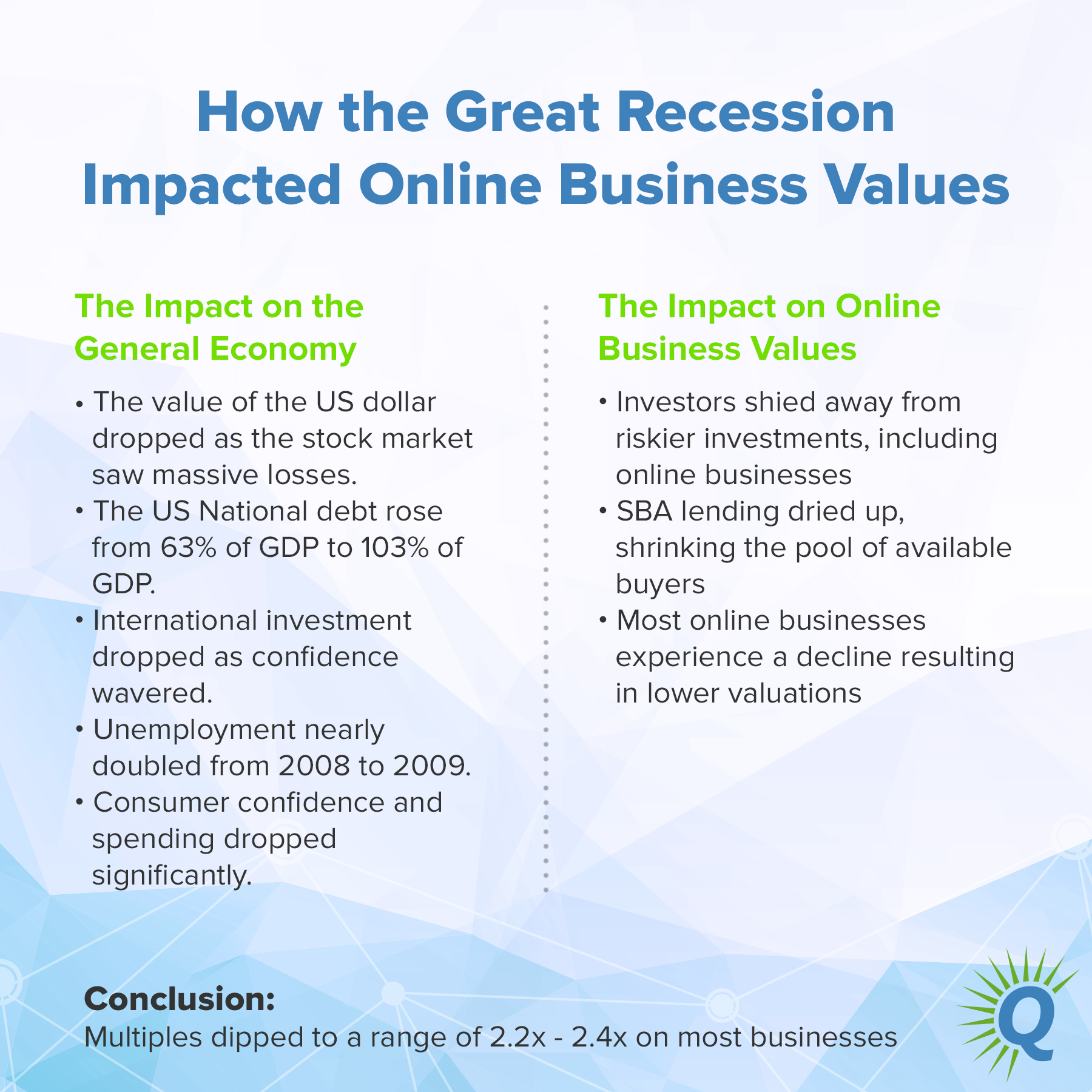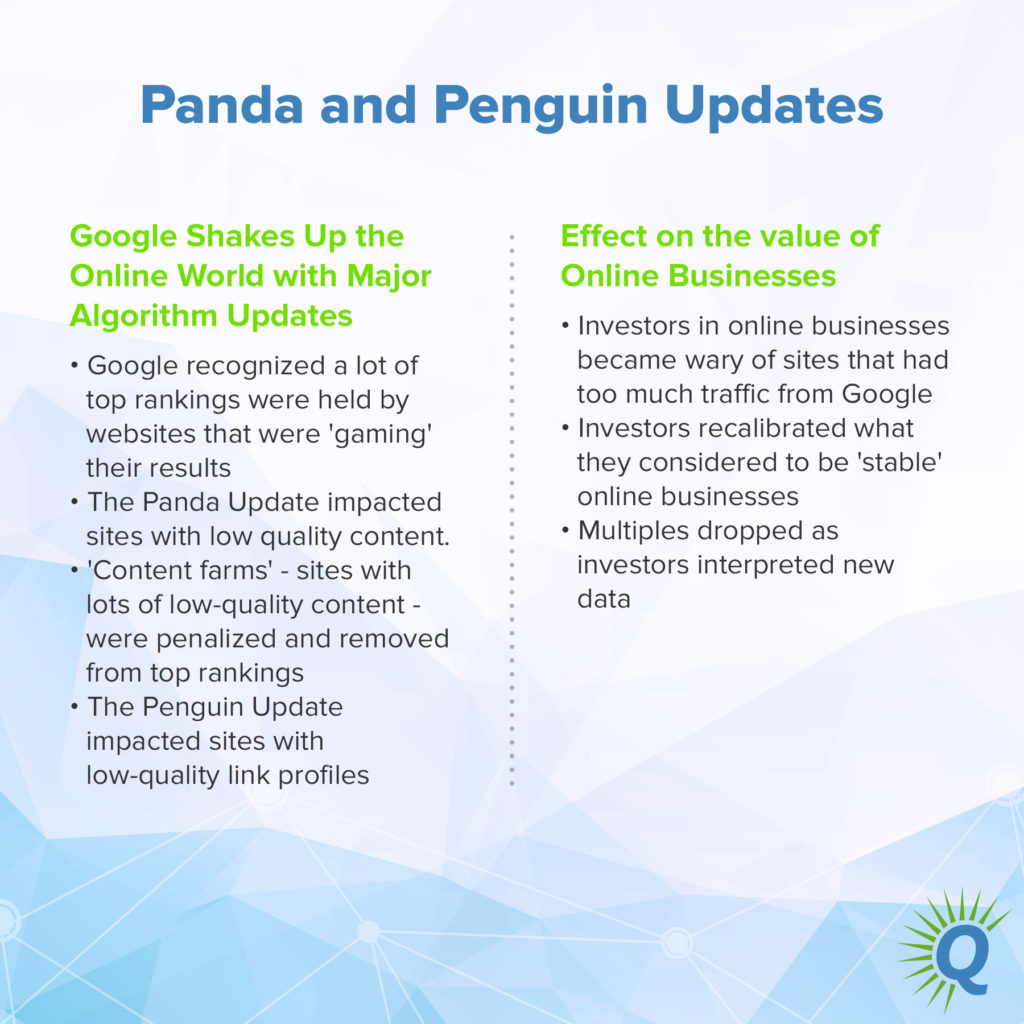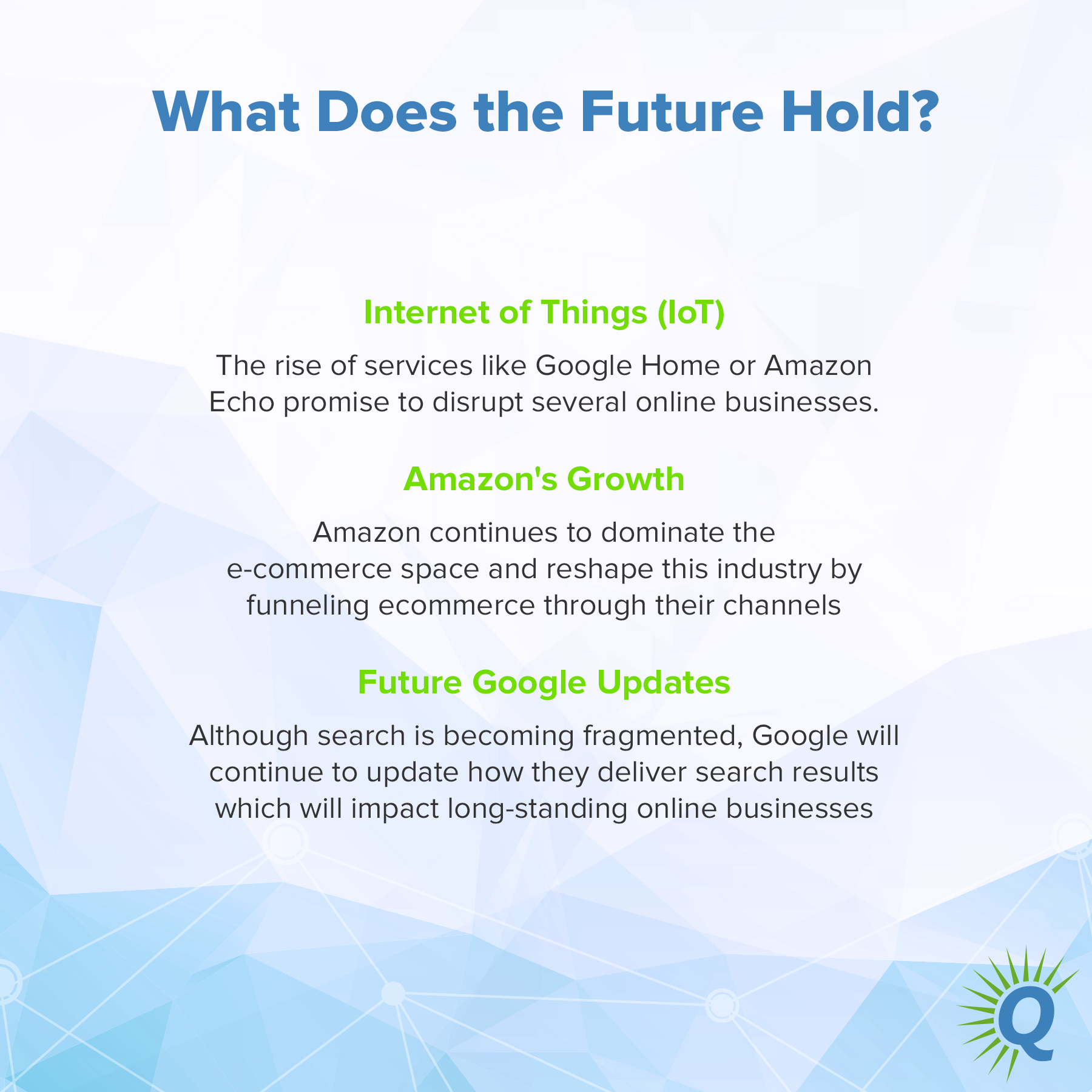Topics:
Never Miss a Beat - Get Updates Direct to Your Inbox
FILTER:


Major Historical Events that Impacted the Value of Online Businesses
By Quiet Light
Since I started Quiet Light Brokerage 10 years ago, we’ve seen the valuation of online businesses fluctuate significantly as major world events and industry events change the landscape of the online environment.
For example, in 2007, multiples were significantly higher than they are today. This is partly because online businesses are much more specialized today, business owners have become savvier, and buyers are more sophisticated with how they value different types of online businesses. As a result, buyers fragment multiples based on the type of business you own.
In addition, major historical events have changed the way investors think about online businesses since those early days in 2007.
Here are four major historical events that impacted how online businesses are valued.
Learn your business’ value with the Ultimate Guide to Website Value today.
Five Historical Events that Impacted the Value of Online Businesses
1. Financial Market Collapse of 2008 / 2009
How was the US economy impacted by the collapse?
- The value of the US dollar dropped as the stock market saw massive losses.
- The US National debt rose from 63% of GDP to 103% of GDP.
- International investment dropped as confidence wavered.
- Unemployment nearly doubled from 2008 to 2009.
- Consumer confidence and spending dropped significantly.
The financial market collapse in 2007/08 had a profound effect on website valuations.
How were website valuations impacted by the financial market collapse?
Risk Averse Investors
At the time, investors pulled their investments from riskier ventures (like online businesses) and put their cash to work in traditionally safe investments.
SBA Lending Declined
The Small Business Administration (SBA) comes is a popular means for buyers who want to acquire an online business, but need access to more capital in order to complete a deal.
However, with multiple banks on the brink of failure, the SBA restricted lending on goodwill to a maximum of $250,000. For an online business (where most of the value is wrapped up in goodwill), this resulted in loans completely drying up during this time.
According to research conducted by the SBA Office of Advocacy, bank lending dropped from $659 billion in June 2008 to only $543 billion in June 2011.
On top of that, with the entire nation heading into a recession, most businesses being sold were in decline.
As a result, the average multiples of that time were around 2.2x – 2.4x.


2. Financial Recovery and Automated Businesses
Financial Recovery
Although there were still challenges to be faced, around 2010 the markets seemed to be on the road to recovery.
According to the New York Times, this is what the US economy looked like in 2010:
- Exports were booming.
- Private job growth returned.
- American families stopped spending frivolously and began saving frugally.
- Many of the businesses that were in decline during the great recession were now growing again.
- Banks were forced to raise capital and disclose their accounting books and therefore they put themselves in a stronger, more competitive position for financial growth.
Automated Businesses
Investors slowly made their way back to online investments.
One category of online investments that investors were drawn to were Adsense websites. These businesses were particularly appealing as they required little to no workload, generated healthy income streams passively, and seemed to have a certain future by pulling in traffic from top Google rankings.
How were website valuations impacted by the economy’s recovery and the rise of automated businesses?
As investors started to wade back into the online markets, top end multiples started to break the 3x barrier with some listings reaching 3.2x values.
3. Google Makes Major Algorithm Updates
Google’s release of the Panda and Penguin updates shook the market in 2011/12.
Before these updates, a website that held top rankings in Google for several years was considered to be a safe investment. After these updates, investors viewed traffic from Google as a complete unknown.
The purpose of the updates was to penalize websites and blogs that were:
- Using link building to increase the quantity, not quality, of their articles.
- Keyword stuffing their articles.
- Spamming website visitors with dishonest doorway pages.
- Publishing poor, irrelevant content to generate more website traffic.
In hindsight, more online entrepreneurs should have seen these changes coming. After all, before these updates, there was fairly widespread abuse by savvy online entrepreneurs who knew how to manipulate Google’s algorithm to rank higher.
While a lot of these entrepreneurs had perfectly legitimate websites, many websites were built with low-quality content geared more for a search engine bot rather than a real human user.
The release of these updates this affected the value for online businesses that were doing exceptionally well cheating the old algorithm.
Panda Update
The Panda update, released in February 2011, was designed as a filter for Google to distinguish low-quality content from high-quality content.
Before the update, ‘content farms’ were publishing a large volume of low-quality content. As a result, they were ranked highly on Google searches and generating lots of income.
After the update, content farms and low-quality websites were penalized or banned from Google.
The update affected 12% of search results in the US.
Retail Me Not’s website traffic dropped from 22 million to 13 million because of the updates.
Penguin Update
The Penguin update, released in April 2012, was designed as a filter for Google to distinguish the low-quality links from high-quality links.
Before the update, websites were buying or acquiring low-quality links from:
- Low-Quality directories
- Blog spam
- Link badges
After the update, websites that relied on superficial links were penalized, and Google decreased their rankings.
How were website valuations impacted by the Panda and Penguin updates?
Many investors who had recently bought an online business that generated revenue by virtue of top rankings in Google lost their investment in its entirety. Our own Joe Valley had this happen just before he joined Quiet Light Brokerage.
More importantly, however, investors who were not as familiar with the space saw online investments as risky, lost their confidence, and decreased their investments.
With fewer investors, multiples dropped.


You can know your business’ value today by using our Ultimate Guide to Website Value.
4. Slow, Steady Recovery
The Economy
In 2014, the economy continued its slow, plodding recovery, increasing consumer and investment confidence.
- After nearly four years, the deleveraging (or debt reducing) process was finally close to being completed. In other words, the economy was finally in a position to begin healthy growth.The fiscal deficit was finally decreasing from about $1.4 trillion in 2008 to $500 billion in 2014.
- The fiscal deficit was finally decreasing from about $1.4 trillion in 2008 to $500 billion in 2014.
- The EU took a hard hit during the crisis as some of their smaller, less stable economies (that were already having trouble) debts grew larger, dragging down the entire euro zone. As these economies stabilized, trading began again (especially from China), which positively affects the rest of the world’s economies (including the US).
- The energy boom in the US assisted in the steady growth of the economy at 0.5% of real GDP/year.
How were website valuations impacted by the economy’s slow recovery?
Investor Confidence
Investor confidence grew, and money started flowing into the online market.
Plus, after the shake up of Panda, Penguin, and subsequent algorithm updates, there was enough research on why these updates occurred in the first place. Investors had a better idea of what they were looking for out of their purchase of an online business, what could be considered stable sources of traffic, and what businesses were less immune to similar disruptions in the future.
In other words, investors started targeting businesses that matched their investment goals (SaaS, e-commerce, Amazon, etc.).
Lessons Learned from Google Updates
After learning from Google’s Panda and Penguin updates, businesses owners began building their businesses on more diversified sources of traffic (rather than just search engine rankings).
The average multiple began recovering in 2014 as investors starting seeing websites generate quality content that is recognized by Google’s Panda and Penguin update, bringing value back to the industry.
5. Present Day
What affects the average multiple in today’s online environment?
Growth of Amazon
The growth of Amazon and the continuing trend of e-commerce stores moving over to Amazon is currently the biggest opportunity and biggest threat to change multiples, specifically in e-commerce.
Rise of Mobile and IoT
In addition to Amazon, the continued move of users to increasingly adopt mobile devices and the Internet of Things (IoT) over desktop will force many businesses to consider where their online business resides; is it a website? An app? Or figuring out how to work with devices such as Google Home or Amazon Alexa?
Google Updates
Despite Amazon and Apple cutting into Google’s online dominance, their algorithm updates are still major influences to current valuations.
Major World Disruptions
It should go without saying that significant world disruptions will impact investors appetites for online businesses.
Changes in Tax Code
President Trump’s proposed plan for a tax reform is supposedly going to give small businesses some tax relief.
The plan is to reduce tax brackets from seven to four to reduce the tax rate and allow fewer deductions. Trump also wants to reduce the tax rate to 15% for freelancers, sole proprietors, and unincorporated small businesses, a category which most online businesses fall under.
If the tax reform passes, online businesses will benefit as they will have more money to put towards their businesses, increase their value, and therefore increase the average multiple.


Conclusion
I often talk about how important it is to get the timing right when you sell your business. Usually, I discuss how to analyze your own business to determine when it reaches a good time to sell.
But events outside of your control also have a major impact on the value of your business.
The six historical events mentioned above were just some of the major events that impacted valuations in the past.
Time to give us your best predictions: what do you think could positively or negatively impact valuations in the future?
Interested in knowing your business’ value? Get the Ultimate Guide to Website Value.
Comments are closed.






Excellent historical recap and a great reminder that in addition to macro risks, other unforeseen risks can have a major impact on valuations.
Predictions: This asset class becomes more recognized as being institutionally investable and Baby Boomers/ Gen X start to invest to fund their longevity and retirement. Both of these trends impact multiples positively.
I definitely agree with your predictions. Those in a position to invest are learning more and more what makes a stable internet based business. This will make these types of investments more appealing (especially given their relative rates of return) which will bring in more investors.